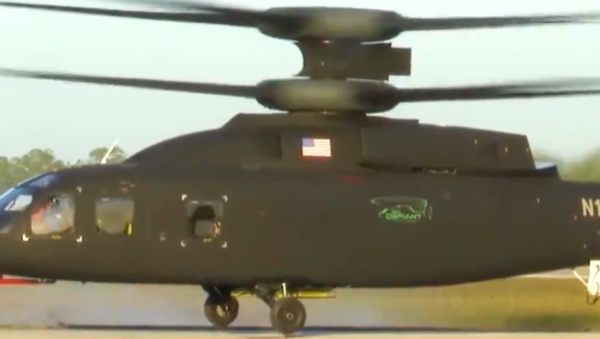According to a report by Military.com, the Defiant, which is powered by two Honeywell T55 turboshaft engines, could become the US Army’s new future Long Range Assault Aircraft (FLRAA). The UH-60 Black Hawk is a medium-lift utility helicopter used by the US military and designed by Sikorsky Aircraft.
— SecArmy (@SecArmy) February 20, 2020
The Defiant was designed to be able to fly at more than 230 mph. The craft also includes a “coaxial rotor system and a large rear propeller that replaces the tail rotor found on conventional helicopters,” Military.com reported. Test pilots also told the outlet that the craft’s rear pusher propeller is designed “to provide revolutionary thrust.”
"It's all self-contained back here; you can take significant combat damage back here, and if you lose the prop, you are still a 150-knot machine," Ed Henderscheid, a former US Army AH-64 Apache pilot and Boeing's lead test pilot for the Defiant, is quoted as saying.
The Defiant’s pusher propeller is fully electric, unlike the hydraulic systems used in most helicopters.
"Not having hydraulics in the tail boom as a helicopter pilot is a huge deal. I have had hydraulics failures where they were caused by a break in the hydraulic line ... and it's scary when you have to go to keep your tail rotor where you want it. Not having to worry about a leak ... or some mechanical failure - that's a really, really comforting thought,” Henderscheid explained.
— Boeing Defense (@BoeingDefense) February 18, 2020
Sikorsky, which is part of aerospace company Lockheed Martin, and aircraft manufacturer Boeing partnered to build the Defiant for the Army as part of the Joint Multi-Role Technology Demonstrator (JMRT-D) program.
The US Army also awarded a contract to aircraft manufacturer Textron to build a tiltrotor-design helicopter, the V-280 Valor, which underwent its first test flight in December 2017. The Valor and Defiant are both competing to replace the UH-60 Black Hawk.
According to Defense News, the Valor flew at 200 knots during a January test flight, compared to the Defiant’s 140 knots during its Thursday demonstration. A knot is a unit of speed equal to around 1.85 kilometers per hour.
However, according to Military.com, the Defiant flew at 140 knots “but only used about 20% of the pusher propeller capability and about 30% of the engine power on Defiant.”
"You translate that power into the prop and you go faster. The requirement that we needed to design around is 230 knots, and we will easily hit that,” Henderscheid is quoted as saying.
Tim Malia, director of US Army's Future Attack Reconnaissance Aircraft (FARA) effort, told Military.com that the Defiant’s X2 technology will improve survival rates among combat aviators.
"You are now getting in faster and you are getting out faster, so you have reduced the amount of time you are in a dangerous environment," Malia said.
The X2 technology also allows for more agility and maneuverability, Malia added.
"The conventional rotor system has a lot more give, think about it like the ride of Cadillac - it's less responsive. When you get to a rigid rotor system, it's more like you are talking about a Porsche or a Ferrari in the level of responsiveness,” Malia explained.
The Army is expected to complete its risk-reduction phase for the new FLRAA in 2022, which is the same year the service will pick a manufacturer to build the Black Hawk replacement.
"What these tech demonstrators are providing is great data back to the Army to understand what the future rotorcraft capability could be," Jay Macklin, director of future vertical lift business development for Sikorsky, is quoted as saying by Military.com.
"The Army is going to take all the information that is learned through the JMRT-D program, and it is going to come up with what it feels is the best design to move forward in the FLRAA competition,” Macklin added.


